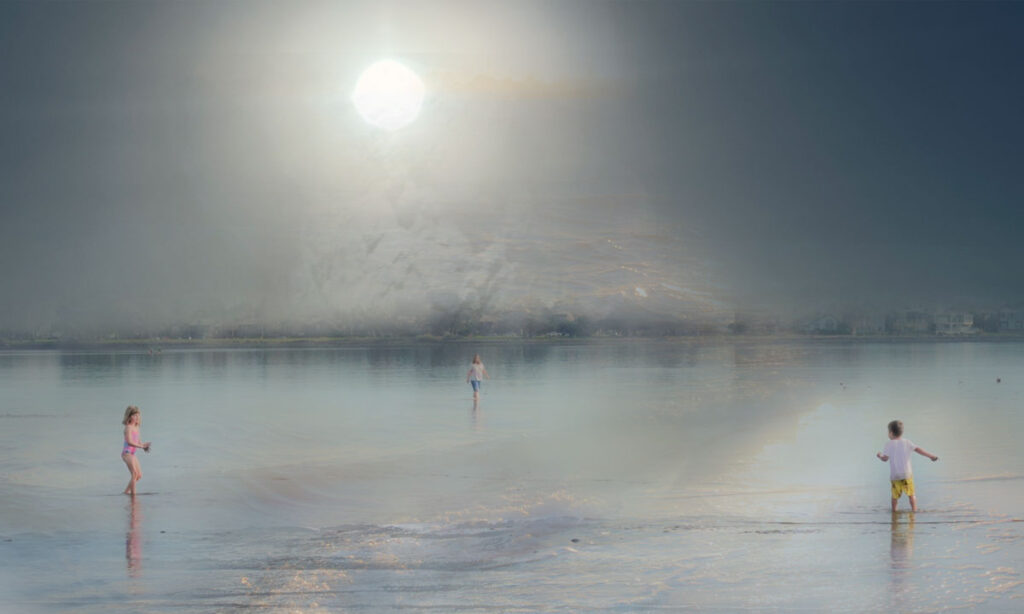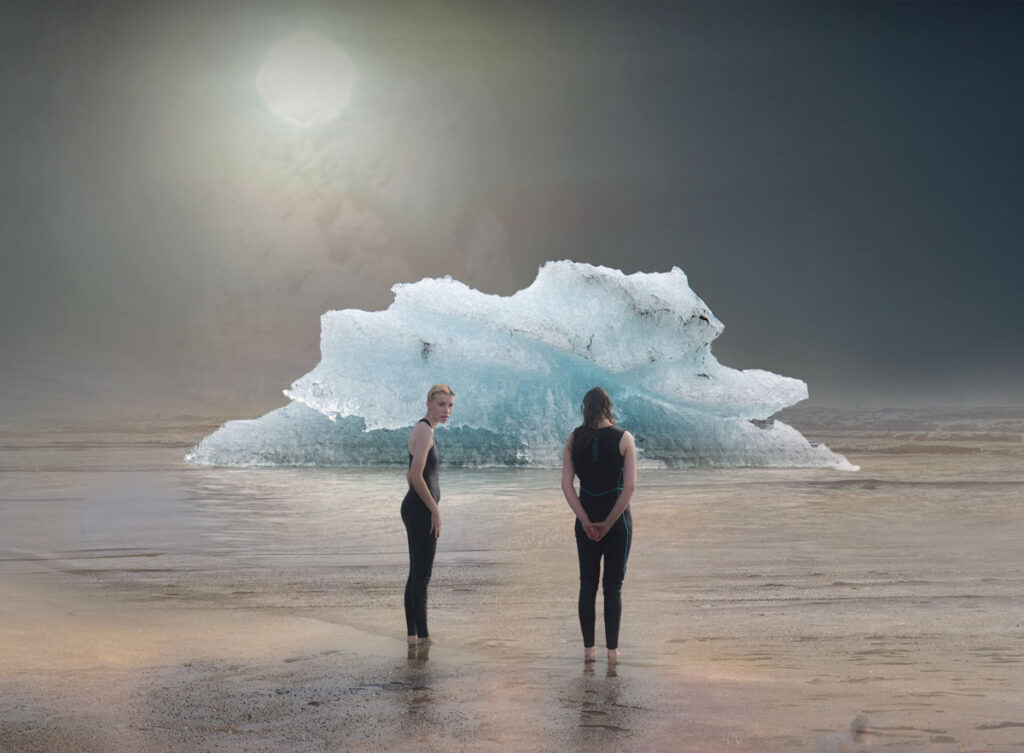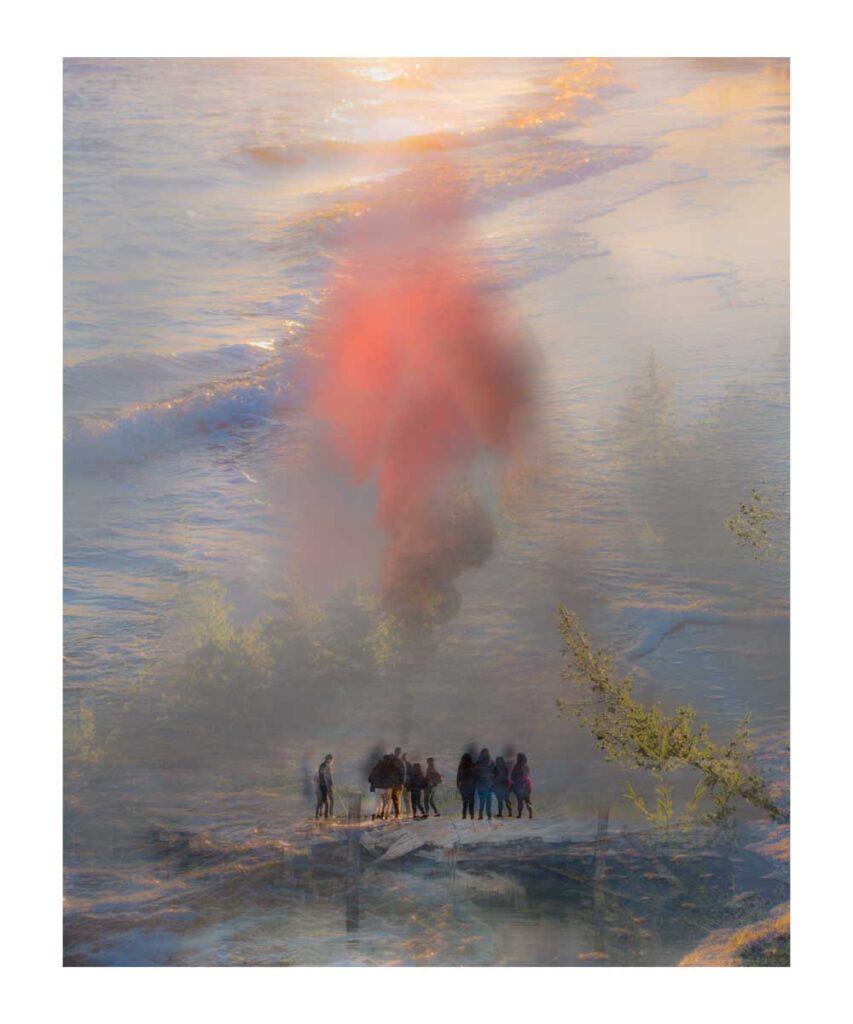Conducted with the Climate Art Collection, Berlin, 2023
CAC: What is your climate change story?

Vida: Well, there’s no way that I could not become aware of climate change. What got me really into it, aside from just following the news, was that one of the schools where I was teaching asked me to teach environmental ethics, and I didn’t like any of the textbooks. I started putting together my own course, framing it with climate change since every other issue has to do with climate change.
Most of the textbooks tack it on as just one more environmental issue. Then we had the fires here in California, and I began taking photographs. I’ve been doing photography for a long time, and during the fires, there were beautiful sunsets, due to the reflection of particulate matter. And I just wanted to get back to work in art. I have a history of going back and forth between writing and art. It had been a while. I didn’t want to start using all of these toxic chemicals that I used to use for multimedia collages. So, I started learning Photoshop, and then it just happened.
I needed to figure out how to start saying what I wanted to say. I continue to teach environmental ethics and to read more in environmental philosophy and to follow what’s going on.
I’m teaching at a different school now, the University of San Francisco, and I requested that I continue to teach environmental ethics because I want to keep going more deeply into the subject matter, to learn more, and to look for where there’s hope.
CAC: And did you find this hope already?
Vida: Well, I think kind of – there’s this thinker, Daniel Christian Wahl; he is one of the regeneration theorists. As he points out, and I believe he is correct, there is a species-wide rite of passage occurring right now. And we are in the midst of it…we don’t know exactly what’s going to happen, but I think there is a huge shift in consciousness going on. And it’s mostly young people driving it. There are certainly a lot of philosophers and writers who are much older, and there are all the people who were warning us about this decades ago. But I think that it’s taking root in the younger generation in a way that’s hopeful.
CAC: We showcase your digital collages in conFRONTtation. Can you talk about the creative process behind them?

Vida: I take photographs when something speaks to me, and then I’ll collect all these photographs, but I don’t know exactly what’s going to happen. I just know that somehow, whatever the image is, it’s going to find its way into a story. I see myself telling stories in each picture. It’s an intuitive process, and sometimes I’ll work on a theme for a while. I knew when I went to Alaska I was going to take photos of icebergs and melting glaciers. So I did quite a few images that had those photographs worked into them. It’s wherever my emotional attention is – I am trying to articulate something visually rather than in words. And it’s often a surprise to me how it turns out. I have no idea what it’s going to look like. So that’s how it works.
CAC: You said that you prefer working digitally because you did not like working with toxic liquids. Do you prefer it because of the environment? Do you think that the art we create or our way of living needs to be sustainable?
Vida: Well, that’s a difficult question because we’re so trapped in a system. I mean, the servers take energy. But definitely, I didn’t want to use as many resources. But I also saw that I could do the kind of art I used to do if I used Photoshop. And I tend to work small. I’m not really interested in huge attention-grabbing things. But, yes, there were environmental concerns in what I chose to do as well as health concerns.
CAC: And you said that you went back and forth from being an artist to teaching philosophy. How does or does your academic work interfere with your role as an artist?
Vida: Actually, now, this is probably the first time in my life when I’ve been able to work on both at once. And I would go for years working on art. And I would come back to ideas, and I finished my PhD dissertation kind of late in life. And then I missed the art. I realized that there were other ways to talk about or say or express what was affecting me so deeply about what’s happening to the environment. And so, now I just go back and forth. I do a little writing. I teach. I’ve always got something that I’m working on. And if I can’t think anymore, I open an image. And so I’m very pleased with that process right now. I get to satisfy both parts.
CAC: Is an artist automatically a philosopher?
Vida: Yes, in the sense that in both processes, you’re sort of following an edge of a kind of awareness that needs to be articulated. And it gets articulated in different ways, either verbally or visually. And I think of people being true to themselves, they’re trying to catch from their perspective this edge of a collective consciousness, the problems in it, and the ways that it might be shifting. And so, if I can put words around the images, that’s kind of what I’m doing. And others as well.
CAC: Do you believe that art as a way of expressing yourself is important in communicating political topics?
Vida: I think it can be, but I guess I want to make a distinction between different kinds of political art. If the statement comes out in the process of a larger frame in a way – if a person undertakes to just be political, that’s kind of like posters. I have nothing against those. I think art is sort of indirectly political. Or that’s how I see it anyway. I mean, other people may see it differently.
But I think in trying to articulate these changes in consciousness – I mean, there are many, many different ways that people try to raise awareness and art’s just one of them.
Indirectly it does make a political statement – but I personally don’t want to hit people over the head with making political statements. That’s not how I see what I’m doing. Others may see it differently and that’s fine. [Artist adds comment: this particular image does hit people over the head!]

CAC: Would you still say that you have noticed an impact on people who view your art?
Vida: Yes, you know, some of my friends, they’ll look at the images – they’ll see it right away. And then other people just walk right by. It depends on whether they see, whether it resonates. I’m not interested in making something that blends in with a person’s decorum and matches the couch. There are all these consultants who work in hospitals and corporations and offices and so on. And they try to match up the decorum. But other people get it right away. Anyway, this is conceptual art and they see it. And so, I don’t know., I put it out there and see what effect it has. It is about what the viewer does with the art, right?
CAC: I think you wrote about it on your website, and I talked to another artist on our series about it. It’s geoengineering. What are your thoughts on that?
Vida: Oh, God. We just covered this in class.
Well, there’s different kinds of geoengineering. The most extreme version being climate engineering with aerosols. There are people who, like David Keith at Harvard University, are big boosters of that. The aerosols that come from the extreme forms of geoengineering would put pollution back into the environment.
And I sort of suspect at some point that we are going to have something like that, but I’m totally against it.
There´s other kinds of geoengineering that are more benign, carbon sequestration, a lot of people are working on that. Who knows? Maybe they will find a way that uses less enerrgy – – right now, the energy it takes isn’t necessarily cost effective.
And then there are other people working on engineering forests. It´s gene editing, creating trees, and then putting them into forests. I’m not sure that I like that idea either, because a natural forest has all this natural fungal network that builds up over time and it sequesters carbon. I’d rather go the route of increasing our forests, but I’m not sure it’s going to be sufficient. The eco-modernist people are really powerful.
They’ve got money behind them. They think that we have a technological fix for everything. And they rely on the idea that we’ve always engineered our way out in the past and we will engineer our way out again. And that speaks more to the capitalists [neoliberals] and it also speaks to the fossil fuel people because they think they can just keep on doing what they’re doing and somebody will fix it for them. So we’re in the middle of that right now. And then we have the people who are motivated by regenerative ideas.
And there are thousands of groups of people and organizations on that side too. They’re a little quieter, but they’re trying to make more noise. So I think we’re going to have a mixture of both and we don’t know how it’s going to turn out. We’ll see.
CAC: Do you think there’s a way to maybe change this human habit that we have of consuming the earth? Vida: Oh God. CAC: It’s a broad question I know.
Vida: Yes, I know. It’s really easy to guilt trip individuals but we’re stuck in a system that is based on extractive capitalism and consumption. And a lot of individuals are going to feel really guilty and they say, no, I can’t radically change my habits. II ran into this in my class when we were discussing the climate effects of raising animals for food. Some students will say they can’t stop eating meat and that poor people can’t afford vegetables–all they can afford is fast food. Difficult problem. But, can’t we cut down meat consumption? Anyway, I think I have to have some hope and faith in this changing consciousness. As environmental problems become more severe and they will, people are going to be jolted into having to scale back. We’re going to have to scale the whole human thing back. I’m heartened by the fact that the de-growth economists are gaining popularity. Nobody ever heard of them in the 1970s and also the donut economists. The donut people – they want to design an economic system that takes into account planetary boundaries on the one hand and human needs on the other and design institutions that do not undershoot on the human needs side and not overshoot on the planetary boundaries side. It is idealistic but also if we can’t imagine it, we won’t be able to do it.
CAC: What do you think needs to happen politically? What needs to happen to prevent reaching this point of no return on climate change?
Vida: Well, I’m more hopeful about other places than the US. People here have been electing all of these Trump clones. And I’m scared – it’s got to change. We have to start electing different people. But the US is not in very good shape right now. It’s got to change.
And I don’t know how. We have so much polarization and people who can’t talk to each other. That has to change. I don’t know what it’s going to take. I’m more hopeful about other areas of the planet. Europe is better, although you have your far-right parties too. Some of those are interested in the environment, but they couple it with anti-immigrant rhetoric. But I don’t know how to really answer that. I just know it has to be different than what it is now.
And I’m hoping that as more young people with their climate awareness are voting and organizing that there will be a political shift. Young people are very interested in environmental justice too.
Personally, and this is perhaps idealistic. Climate change affects different parts of the planet differently and it has produced tragedy in many parts of the world and it will produce more. It’s true that the billionaires can insulate themselves for a long time but most of us cannot. I believe climate change is the one issue that has the potential to reveal to people what they share as living beings, especially as more of what we have taken for granted in the background is threatened and therefore threatens the habitability of the earth. The planet is a commons—there is no way around that.
CAC: Do you see a sort of activism or artivism in your students? Yes, but I get a lot of environmental studies majors in my class and environmental science majors – they’re definitely very aware.
But I asked the students at the beginning of the term: How many of you are concerned about the climate? – Every single hand goes up! It doesn’t matter what their majors are. They’re scared. Every term the same thing happens, when I ask that question – there’s a lot of awareness. And, fear is a motivator.
CAC: Thank you, Vida!
